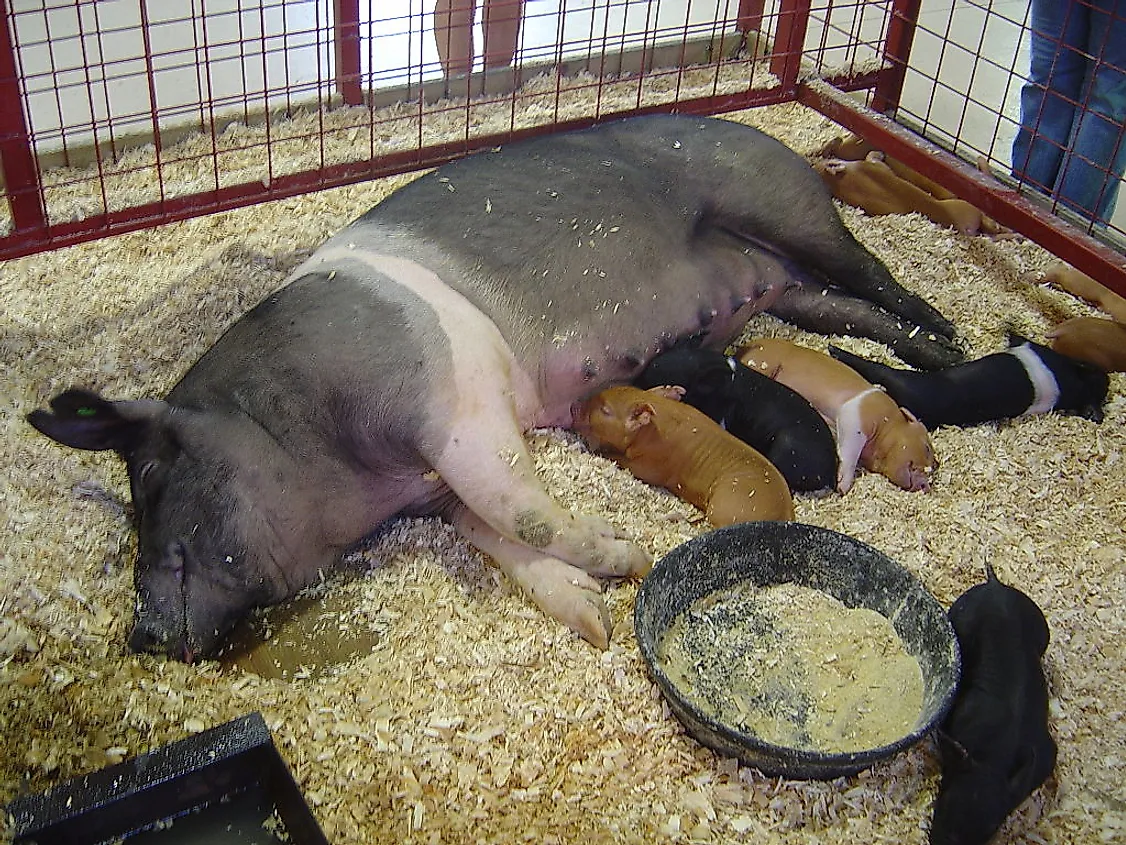Top 20 Pork Exporting Countries

Pork is the culinary name for the meat that comes from domesticated pigs. Pork is the most widely consumed meat worldwide and one the most widely consumed foods in the world. Wild pigs were domesticated around 9,000 years ago, and evidence of pig husbandry dates back to around 7,000 years ago. The consumption of pork is also forbidden in Islam, Judaism and some Christian denominations. Now that some of the basics behind pork have been discussed let us see the process behind exporting it.
The Pork Exporting Process
There are a few free-range systems to raise pigs in which they have full access or some access to the outdoors, are allowed to fully express natural pig behaviors, and are usually given no additives, medicines, and other substances. The is an outdoor pig farming process in which piglets are born and raised outdoors. After the weaning period, the pigs move inside to a deep litter house to fully grow. In factory farming, pigs are born and raised in farrowing crates for the first few weeks of their lives. The pigs are then stuffed in small metal-barred crates, with concrete floors, where they will live for around the next six months until they reach slaughter weight. In this environment, the pigs suffer from all kinds of physical and psychological issues, as well as being given all kinds of additives, drugs, and medications. When pigs are fully grown, they are put on trucks to be taken to slaughterhouses.
Processing
The first step for the pigs when they arrive is to undergo antemortem inspection to be approved for slaughter. Pigs that pass the inspection are stunned and then killed. Then the carcass bleeds out to not affect the meat. The carcass then goes through a process of being cleaned, washed and having all of the hair removed. Then the carcasses are inspected to make sure that they are safe to be consumed. Some factories will ship out whole carcasses at this point, but most factories have the carcass go through the fabrication process first. This process involves taking the carcass and breaking it up into large cuts called primals. These primal cuts are then reduced to smaller cuts called subprimals and portion cuts. These cuts are then fathered refined and processed before being placed in cold storage and then are prepared to be shipped out. Pork is rarely graded by the United States Department of Agriculture (USDA) and instead quality is determined by lean percentage, loin eye depth or back fat.
Shipping
Pork that is being transported is warped in stockinette, a loosely knitted fabric. The pork is then transported by being suspended on hooks as the pressure caused by stacking pork would result in the loss of meat juices. Frozen pork meat can be transported over longer distances than fresh port meat. Frozen pork meat is usually transported via boat or train, while fresh meat is usually transported by truck. Regardless of if it is fresh or frozen, the pork meat is placed inside refrigerated containers to keep the meat at its desired temperature and prevent it from going bad.
Uses of pork
Most of the carcass of a pig is used to produce various types of different pork meat products. In the case of suckling pig, which is popular in Asia, Europe, Latin America, and the southern U.S., the whole body of a young pig is roasted. Pork is also a common ingredient in sausage, salami, and hot dogs. Ham and bacon are probably the two most popular meats made using pork meat, especially in the western world. The well known canned meat Spam is also made using chopped pork shoulder meat along and ham.
Top Importers Of Pork
According to Observatory of Economic Complexity (OEC), the world's top importer of pork is Japan, who imports 14% of the world's pork. The countries that round out the rest of the world's top five pork importers are Italy (8.7%), Germany (7.4%), Poland (5.3%) and Russia (5.0%). The biggest pork importers in other regions of the world not covered are Mexico (4.9%) in North America, Australia (1.9%) in Oceania, Colombia (0.53%) in South America and Angola (0.48%) in Africa.
Top 20 Pork Exporting Countries
| Rank | Country | Swine Meat Export Value in 2015 (USD) |
|---|---|---|
| 1 | United States | $4,019,415,000 |
| 2 | Germany | $3,971,070,000 |
| 3 | Spain | $2,998,204,000 |
| 4 | Denmark | $2,523,195,000 |
| 5 | Canada | $2,235,287,000 |
| 6 | Netherlands | $1,939,356,000 |
| 7 | Belgium | $1,310,014,000 |
| 8 | Brazil | $1,168,415,000 |
| 9 | France | $828,895,000 |
| 10 | Poland | $757,948,000 |
| 11 | Ireland | $415,678,000 |
| 12 | Mexico | $394,576,000 |
| 13 | Chile | $391,379,000 |
| 14 | Austria | $378,635,000 |
| 15 | Hungary | $342,221,000 |
| 16 | China | $322,399,000 |
| 17 | United Kingdom | $301,372,000 |
| 18 | Italy | $186,462,000 |
| 19 | Hong Kong | $142,845,000 |
| 20 | Portugal | $123,246,000 |











